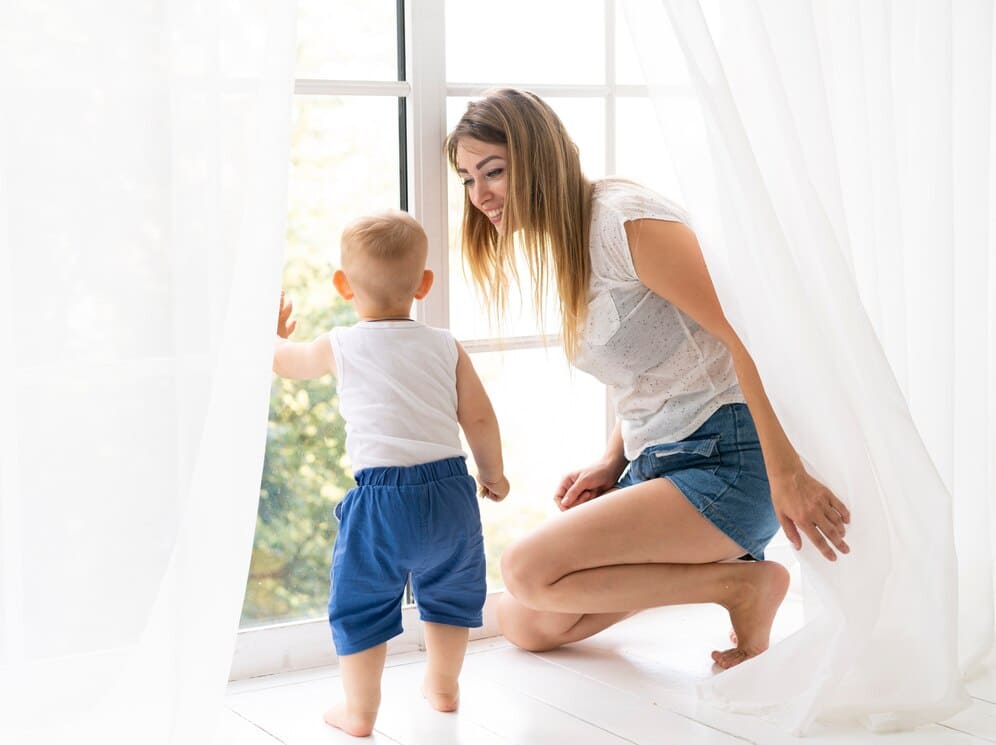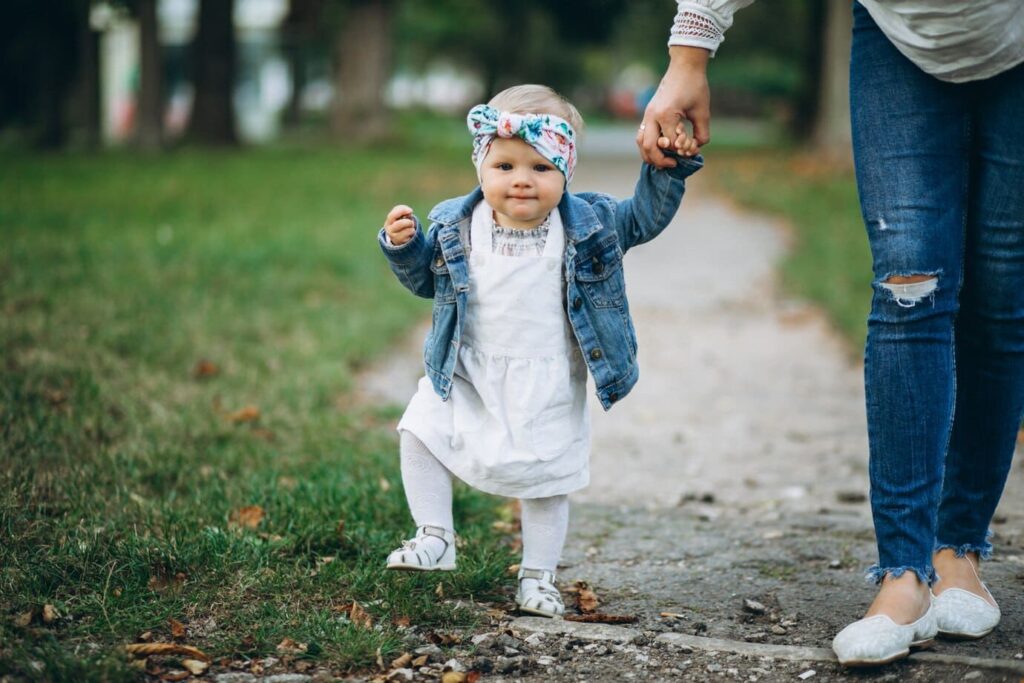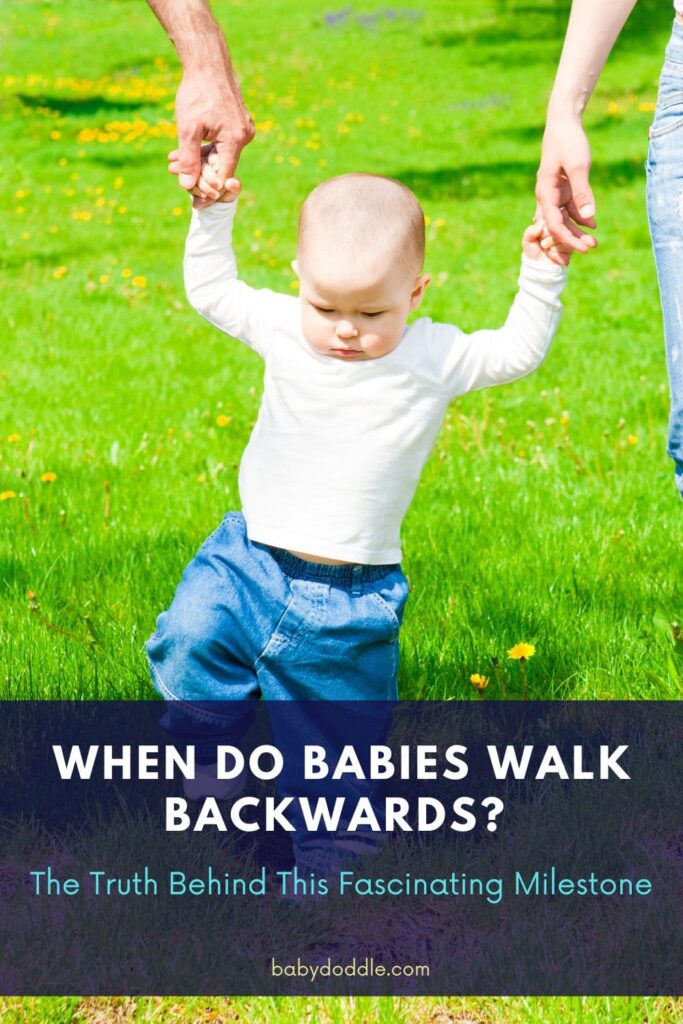When Do Babies Walk Backwards? That question started swirling through my mind recently as I noticed my 14-month-old daughter Amelia taking some tentative backward steps for the first time.
I decided to dig into the research on When Do Babies Walk Backwards – and discovered there’s much more to this milestone than meets the eye!
It turns out that mastering backward walking provides tremendous developmental benefits for balance, coordination, muscle strength and even brain connectivity.
As a pediatric physical therapist and mom, I want to spotlight when this often overlooked achievement typically emerges, why it matters, how to encourage budding backward walkers, potential red flags and more.
Let’s start at the beginning…
When Does Backwards Walking Usually Start?
When can you anticipate your baby first walking backward? Experts say most babies take their first purposeful backward steps between 13 and 15 months on average. However, it’s common anytime between 10 and 18 months.
My daughter Amelia didn’t reliably walk backward until a couple of weeks before turning 14 months old. But some babies surprise their parents with the skill as early as 10 months!
While the exact age range varies quite a bit depending on the child. Rest assured, minor delays in backward walking are rarely cause for concern if babies are otherwise developmentally on track.
So when do babies walk backwards? For most little ones, their first tentative or accidental backward steps emerge between 10-14 months. With confident, purposeful backward walking developing anytime from 13-18 months old.
Now that we know when it typically starts – let’s look at why walking backward matters in the first place…
| Backwards Walking Milestone | Typical Starting Age Range |
|---|---|
| First hesitant backwards steps | 10-14 months |
| Brief backwards bursting | 12-15 months |
| Confident backwards walking across rooms | 13-18 months |
Why Do Babies Learn To Walk Backwards?
There are a few key reasons experts believe backward walking emerges around the one-year mark:
To Improve Balance and Stability
Learning to walk backward while distributing weight helps reinforce core stability at a crucial developmental stage.
To Build Leg and Back Muscle Strength
Walking backward requires gently stretching different groups of muscles – strengthening little-used leg and back extensions.
To Explore New Physical Skills
As curiosity about their expanding abilities grows, purposefully propelling themselves backward represents a whole new world to conquer!
To Show Off For Parents’ Reactions
You better believe once they’ve nailed this trick, toddlers will excitedly walk backward seeking attention and praise!
And what’s wild is that the benefits don’t stop there…

The Surprising Benefits of Mastering Backwards Walking
When I discovered the spectrum of perks walking backwards offers babies in strengthening both body AND mind – I was stunned!
Here are a few powerful advantages:
Enhances Balance, Posture and Coordination
Backward walking improves stability, upright alignment and overall coordination – key foundations for mobility.
Strengthens Neglected Muscles
Stepping backward gently tones the calves, hamstrings, glutes and core. Muscles often underworked as babies walk forwards.
Increases Heart Rate and Burns More Calories
Walking backward has been shown to burn up to 20% more calories per minute than regular walking!
Boosts Brain Connectivity and Spatial Awareness
Navigating the world walking blindly backward sparks new cognitive connections and spatial processing abilities.
And if all that wasn’t enough proof that such a seemingly simple skill delivers transformative benefits – get this…
Backward Walking Case Study with Cerebral Palsy
Fascinating research on children with cerebral palsy discovered that targeted backward walking training led to marked improvements in balance, coordination and forward function.
Let’s quickly break down the study:
30 kids with CP aged 6-10 years old were split into two groups. For 8 weeks, both groups received equal strength training, general physical therapy, and gait work.
However, the experimental group spent 30 extra minutes 3x/weekly purposefully walking backwards with pole support.
After two months, the consistency walking backwards paid off! The experimental group showed substantial improvements in pace, stride length, stability, posture and more.
As Marc, a Customer Success Manager who helps kids access movement technology, notes:
There is mounting evidence children can use proprioceptive input and spatial awareness from walking backwards to help learn to walk forwards.“
Needless to say, I am no longer underestimating the value of this humble milestone!
Next let’s get into some fun ways to nurture this emerging skill…
Encouraging Your Budding Backwards Walker
Gently fostering your baby’s budding ability to walk backward through play encourages balance and coordination – while delivering lots of giggles!
Some favorite toddler activities for backwards walking practice:
Dancing Backwards to Music
Hold their hands and step together backwards across rooms in an impromptu dance party!
Playing Follow the Backwards-Walking Leader
Take turns being the backwards leader for waddling little ones to mimic.

Rolling Balls While Taking Backwards Steps
Facing each other while softly rolling a ball helps promote backwards stepping.
When first delving into purposeful backwards walking, start with supportive activities focusing on just a few tentative steps. Offer encouragement and praise!
Over time, increase expectations for distance and duration as your toddler becomes more confident walking backwards solo – across backyards, playgrounds and more.
Of course while all kids develop on unique timelines, some may need extra assistance. Let’s quickly go through potential red flags to keep on your radar…
Fun Backward Walking Games
Incorporating playful games is a fabulous way to nurture backward walking skills while showering babies with encouragement and giggles. Here are some silly activities to try:
The Backwards Boogie – Turn on an upbeat toddler playlist and hold your baby’s hands for an impromptu backwards dance party. Step together swaying across the room, spin in circles clapping, then let them lead solo.
Follow the Waddling Leader – Take turns being the backwards walking leader for imitation. Let them set the pace, then reverse roles. See how long little ones will mimic your steps before demanding a new game!
Ready, Set…Backwards! – Make a race track with sheets, stools or painter’s tape lines. Stand facing toddlers then say “Ready, set, go…backwards!” and see who speedily steps over the finish line first while looking ahead at parents’ cheering faces!
Red Light, Green Light – Tell tots to walk backwards towards you when you say green light, then freeze dancing when you say red light! See how many times you can trick them into extra backwards boogies before they catch on.
These are just a few favorites that promote coordination and confidence while delivering lots of laughs. What inventive backward walking games will you dream up?
| 10-12 months | 12-18 months | 18-24 months |
|---|---|---|
| Backwards dance holding hands | Follow the waddling leader | Ready, set…backwards races |
| Gentle backwards stepping with support | Backwards ball rolling | Obstacle courses |
| Slow-motion reverse crawling | Silly backwards song and dance | Backwards tag |
Backward Walking Safety Tips
Are babies more prone to falls or injuries while navigating their environments walking blindly backwards? Thankfully not necessarily. However, some simple precautions can help keep little adventurers safe.
Firstly, realize tripping or veering course while vision-impaired is developmentally appropriate early on. Lightly guide wobbly walkers holding both hands until they gain more muscle memory mastery. Provide attentive spotting without interrupting progress.
Additionally, clear potentially dangerous spaces like staircases, sharp table edges or water hazards when practicing backwards stepping away from supervision. Consider safety gates securing off risky areas and cushioning hard floors.
Also avoid carrying babies facing outwards against your chest, which pressures them to instinctively walk forwards and can lead to accidents.
In case unpredictable tumbles still occur, prepare by learning proper falling and catching techniques to minimize injuries:
Cradle falling babies’ heads while avoiding abrupt yanking on arms. Skillfully assist lowering down versus forcing upright support. Crouch to floor level when bracing to prevent hard collision against your body.
When in doubt, allow babies to gently sit down rather than overly interfering mid-fall.
While mastering any new physical skill has inherent challenges, with attentive parenting and reasonable safeguards, rest assured your determined darling will quickly transform into a capable backwards walking champ!
Signs Your Child May Need Extra Backwards Walking Support
Talk to your pediatrician if:
Your Child Isn’t Walking Backwards by Age 2
Monitoring milestones is important. While emerging between 10-18 months is average, avoidances beyond age 2 warrant professional assessment.
Your Toddler is Falling Frequently While Walking Backwards
Occasional stumbles are expected. But consistent falling could reflect issues with low muscle tone, vertigo or inner ear function requiring treatment.
You Notice Ongoing Physical Coordination Struggles
If you’re observing wider challenges with balance, strength or execution beyond backward skills, discuss next steps including potential physical therapy.
The great news? When identified and addressed early through pediatric specialist support, even minor motor delays often smoothly resolve.
So if your tiny tot needs a little boost, ask your physician about accessible community Early Intervention options offering Activity-Based Therapy. Research shows that play-based programs can help babies confidently achieve skills like independent backward walking alongside similar-aged peers.
Soon enough, all that dedicated backwards walking practice will have your adventurous kiddo racing around parks and playgrounds – surpassing expectations and proudly showcasing their tenacious muscle memory mastery one accomplishment at a time!
The Science Behind Backward Walking
As babies approach their first birthday, remarkable changes are unfolding in their developing brains, muscles and neural connections that eventually make purposeful backward walking possible around 10-14 months old.
So what’s going on developmentally behind the scenes?
Around a year old, babies’ leg and spinal muscles rapidly strengthen to support not only walking forwards, but also controlling deliberate steps backward. Their balance and equilibrium senses also improve as the vestibular system in the inner ear matures.
Additionally, as babies navigate their surroundings, their spatial processing and understanding of movement patterns adapts in incredible ways. Walking sideways or backwards engages different parts of the brain and sparks fresh neurological connections.
In fact, various studies using functional MRIs reveal that compared to adults, toddlers show much higher activity in regions related to sensorimotor information and spatial processing as they explore new mobility skills. Their brains are actively mapping out rich details about self-movement and the environment.
| Physical Benefits | Cognitive Benefits |
|---|---|
| Enhances balance and stability | Boosts spatial awareness |
| Tones leg and back muscles | Sparks new neurological connections |
| Reinforces core strength | Improves body mapping in the brain |
| Expands mobility skills | Advances understanding of movement |
Over months of cruising furniture and walking forwards, babies gain cumulative muscle memory. Eventually these strengthened pathways allow them to coordinate alternating footsteps while visually impaired – without losing balance!
It’s no wonder pediatric experts consider purposeful backward walking an important developmental milestone. This foundational skill reflects babies’ burgeoning physical confidence, cognitive growth and readiness to advance to even more dexterity like running, crouching and climbing stairs.
The Link Between Backward Walking and Language Development
You might be wondering – how could mastering a physical ability like purposeful backward walking possibly impact babies’ communication milestones like babbling, gesturing or speaking first words?
Yet pediatric experts reveal fascinating connections worth noting. See, when tiny tots intensely concentrate learning difficult new motion sequences, cognitive resources for processing language can temporarily plateau.
Frustrations around coordination struggles also often manifest in behavioral changes like shorter fuses, tantrums or avoidance.
However, as babies gain muscular confidence wandering backwards across playrooms – delight lights up their faces! You’ll likely notice more frequent chatter, receptive gestures and vocal experimentation reemerge soon after.
This interdependent relationship reflects how foundational physical gains unlock mental bandwidth for interactive social engagement through babble conversations…which then motivates more movement practice!
Also around the same stage backward walking emerges, essential nerve networks connecting the left and right brain hemispheres rapidly mature. Researchers believe this increased bilateral brain connectivity plays a pivotal role enabling babies to translate thoughts into words.
So by nurturing balance and resilience during this transitional time, parents help strengthen babies’ neurological wiring to soon make cognitive leaps supporting memory, understanding directions and communicating wants more clearly!
Backward Walking: A Parent’s Experience
“I’ll never forget the moment my son David shocked us by confidently walking backwards across the living room at 11 months old,” recalls mom Margot. “My husband and I watched in awe as he giggled and completely trusted his footing while staring right at us – without even reaching out his arms for balance!”
She continues, “We had been working on gentle backyard play activities to encourage David’s early tentative steps like lightly bracing his hands while he focused on feeling the grass backwards under his feet. But to see him suddenly just take off bravely on his own almost made me gasp!”
Margot describes intentionally creating a safe, positive environment to nurture David’s experimentation. “We showered him with encouragement when he attempted little backwards bursts. I’d cheer things like You’re getting it! You’ve got this! And at the same time, we minimized pressure, never forcing progression.”
She reflects, “I believe that supportive freedom coupled with removing any frustration allowed David’s confidence to just blossom unexpectedly fast – because before we knew it, he was soon walking backwards everywhere he could, begging us to watch his silly stunts!”
Now at age two, Margot reveals David’s early backwards walking milestones have clearly paid off developmentally. “He certainly moves through our days now with total agility and daring as one of the most physical kids I know! But beyond balance and strength, I just think the empowerment he felt then now translates into confidently attempting so many fresh feats.”
Expert Baby Milestone Resources
When evaluating your child’s motor milestones like mastering backwards walking, reputable pediatric health organizations offer helpful tools for reference:
The American Academy of Pediatrics provides reliable milestone checklists by age covering movement, play, speech and social norms through 5 years old.
Pathways.org empowers parents supporting kids with special needs through free education, specialists and advocacy resources vetted by their national federation representing over 100 hospitals.
Zero to Three shares unique child development insights on emerging skills needed to reach infant/toddler milestones from their network of top behavioral pediatric authorities.
Wondering if your baby may benefit from extra physical therapy assistance? Organizations like the American Physical Therapy Association connect families with licensed provider options and treatment financing support in your local community.
For live Q&As with leading experts on milestones, child care coach Dina shares answers stemming from her 30-year parenting education background.
Leverage these reputable outlets for credible guidance you can trust understanding babies’ awe-inspiring development!
What’s Next After Backwards Walking?
Once your tiny tot has mastered those exciting first independent reverse footsteps around 12-15 months, what other incredible physical milestones can you expect babies to start attempting next?
Between 15-18 months old, look for little ones to build full confidence cruising sideways stepping and even gracefully spinning 360 degrees without losing balance!
Soon after, right around 18 months old, prepare to witness new adventures in scaling straight-backed adult chairs to reach exciting new heights! Toddlers will use arm strength boosting up and balanced leg extensions lowering down while parents safely hover close by.
Around this age, babies may also cautiously start rhythmically bending knees up/down in self-taught pre-jumping jacks with both feet leaving floor for brief airtime. Celebrate their tenacious experimentation!
Shortly following confident chair climbing, anticipate a leap into climbing actual staircases right around 20 months old. With an adult’s handheld assistance, little mountain adventurers eagerly crawl up steps on all fours – then emboldened, cautiously back down feet first sitting while gaining grace and courage.
Once steady stair stepping mastery emerges close to the two year mark, fast-paced toddlers thrill in unleashing their newfound upright mobility freedom by suddenly racing across rooms at turbo speed! Parents – prepare for hilarious squealing dashes blurred by galloping little feet once walking transitions into gleeful running.
Who knows what daring new physical feats your tiny trailhead blazer will be proudly pioneering next? But one thing is for sure – with the spatial skills, muscular prowess and emerging coordination gained from early backwards walking confidence, your kiddo will be unstoppably charging onward to new heights!
FAQS – When Do Babies Walk Backwards
At what age do most babies walk backwards?
According to child development research, most babies take their first purposeful backwards steps between 13 and 15 months old. However, initial backwards walking can emerge anywhere from 10-18 months.
Why is the ability to walk backwards an important milestone?
A: Mastering backwards walking helps babies improve balance, stability and coordination. It also builds muscle strength in the legs and back while allowing them to explore new physical abilities.
What are some activities I can try at home to encourage my baby to start walking backwards?
A:Dancing, playing follow the leader, gently rolling balls, and providing anchors like push toys are all fun ways to coax those first backwards steps. Offer praise and increase distance expectations as they gain confidence.
When should I be concerned about my child’s backwards walking progress?
Talk to your pediatrician if your child is consistently struggling to walk backwards or avoid it altogether by age 2. Also discuss any wider challenges with balance, vertigo symptoms, or physical coordination difficulties.
Are there benefits to continuing backwards walking practice even after kids learn to walk forwards confidently?
Definitely! Research shows sustained backwards walking continues boosting balance, posture, coordination, neglected muscle groups, heart rate, calorie burn, and even cognitive skills over time. Keep fostering the skill through play long-term.












